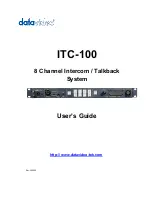
Installation
SD39EAM-1r4
2-20
September 2005
2.8.1 I/O Cable Connections
An EAM Termination Strip and an EAM Marshalled Termination Assembly provide for connection of up
to 16 configurable input or output channels. Refer to the following for I/O cable connections:
1. Consult user EAM configuration documentation and wiring diagrams for assignments to each
channel. Refer to Table 2-1 for terminal identification and connections and Figure 2-9 for wiring
examples.
2. Prepare the cable conductors and shield (see Figure 2-10). Refer to Table 6-2 for wire size, stripping,
and torque specifications.
3. Refer to Table 2-2 to correlate channel terminal connections and terminal strip numbers.
2.8.2 Unterminated I/O Cable
An Interconnect I/O Cable connects an I/O module to a Marshalled Termination Assembly. If the user is
providing a remote termination assembly, an Unterminated Interconnect I/O Cable is required. The
Unterminated I/O Cable does not have connector P2 installed. Wires are instead left for the user to
terminate. Table 2-3 lists the wire color and identification information needed for termination. Refer to
user wiring diagrams to make the proper cable connections to the termination assembly.
2.9
APACS Calibration Verification Requirements - Long Term Drift
The APACS analog I/O is designed to minimize calibration drift and the need for re-calibration over the
life of the product. Design improvements include:
•
Elimination of adjustable potentiometers
•
Elimination of adjustable resistors
•
Use of high quality, low drift components
Calibration is performed through mathematical compensation within the microprocessor program. This
allows the use of matched resistors for voltage dividers and minimizes the problem of temperature
coefficient matching.
Because the other sources of drift have been minimized, the dominant contributor to analog long term
drift for all analog modules is the voltage reference used for the A/D or D/A circuit. Manufacturer data
specifies a typical long term drift in terms of the first 1000 hours of operation. Typically, drift for the
next 1000 hours will be less. In fact, studies have shown that the I/f noise model is valid for long term
drift. This model indicates that the drift will be proportional to the square root of the time period as a
limiting factor.
A drift of 20ppm over the first 1000 hours is a typical drift for a high quality reference such as used in all
APACS analog modules. Using 30ppm to account for the other secondary drifts, such as precision
resistor ratios, indicate it would, on average, take 126 years for a module to drift 0.1% from original
calibration due to this mechanism. Drift of 0.05% would on average take 31 years.
Summary of Contents for APACS+
Page 16: ......
Page 26: ...Installation SD39EAM 1r4 2 10 September 2005 Figure 2 3 EAM Marshalled Termination Assembly ...
Page 27: ...SD39EAM 1r4 Installation September 2005 2 11 Figure 2 4 Marshalling Termination Panel ...
Page 40: ...Installation SD39EAM 1r4 2 24 September 2005 Figure 2 9 Sample Input and Output Connections ...
Page 41: ...SD39EAM 1r4 Installation September 2005 2 25 Figure 2 10 I O Cable End Preparation ...
Page 42: ......
Page 47: ...SD39EAM 1r4 Maintenance September 2005 3 5 Figure 3 1 Cover Plate Securing Screws ...
Page 48: ...Maintenance SD39EAM 1r4 3 6 September 2005 Figure 3 2 User Replaceable Fuse ...
















































